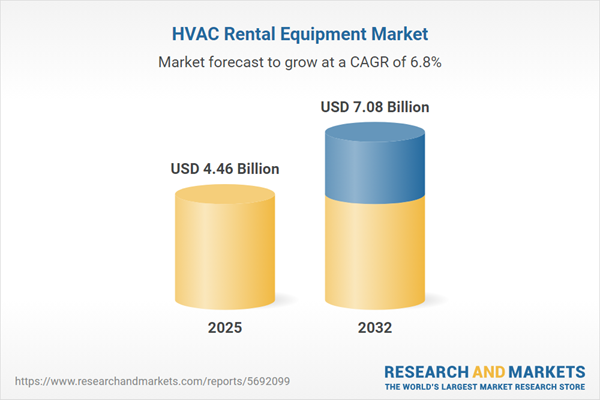Speak directly to the analyst to clarify any post sales queries you may have.
The HVAC rental equipment market is evolving rapidly, offering adaptable and cost-efficient solutions for organizations managing variable climate control requirements. Businesses are increasingly leveraging rentals in response to fluctuating project demands, regulatory shifts, and rising sustainability expectations.
Market Snapshot: HVAC Rental Equipment Market Growth and Trends
The HVAC rental equipment market grew from USD 4.19 billion in 2024 to USD 4.46 billion in 2025. It is projected to expand at a compound annual growth rate (CAGR) of 6.77%, reaching USD 7.08 billion by 2032. The sector is driven by increasing demand for flexible heating, cooling, and ventilation solutions, which help organizations optimize capital and operational efficiency while aligning with evolving environmental mandates.
Scope & Segmentation of the HVAC Rental Equipment Market
The market spans a diverse set of applications and rental models to address the complex needs of businesses globally. Key segmentation parameters are:
- Equipment Types: Cooling (air conditioners, chillers, cooling towers), Heating (boilers, furnaces, heat pumps, unit heaters), and Ventilation (air handlers, air purifiers, dehumidifiers, fans)
- Rental Duration: Long-term and short-term rental agreements suited to project-driven, seasonal, or emergency needs
- Power Sources: Diesel-powered, electric-powered, gas-powered, and hybrid power systems to accommodate site conditions and environmental goals
- End-User Categories: Commercial (hospitality, offices, retail, warehouses), Industrial (food processing, manufacturing, oil & gas), Institutional (education, government, healthcare), and Residential applications
- Regional Coverage: Americas (North and South America), Europe, Middle East & Africa, Asia-Pacific, with country-level insights for all major markets
- Vendor Landscape: Major firms include United Rentals, Aggreko, Trane Technologies, Carrier Global, and other leading global and regional providers
Primary Keyword: HVAC Rental Equipment Market
Key Takeaways for Strategic Decision-Makers
- HVAC rentals empower businesses to sidestep large upfront investments, enabling scalability during infrastructure upgrades or unplanned outages.
- Integrated service offerings now combine equipment leasing with maintenance, remote monitoring, and rapid delivery, strengthening operational resilience.
- Digital connectivity and the adoption of IoT-enabled units are optimizing predictive maintenance and energy usage, transforming fleets into intelligent service assets.
- Providers are introducing low-global warming potential refrigerants and variable speed drives to meet both regulatory and corporate sustainability goals.
- Flexible as-a-service models and modular equipment bundles foster deeper client engagement and create new, recurring revenue streams.
- Competitive differentiation increasingly centers on advanced data analytics, fleet modernization, and responsive service contracts tailored to sector-specific needs.
Comprehensive Evaluation of Tariff Impact
Upcoming United States tariffs on metals and components are affecting procurement strategies and cost baselines across the HVAC rental supply chain. Equipment providers are responding by forming new sourcing partnerships, optimizing inventory in tariff-free zones, and deploying real-time pricing mechanisms to manage cost fluctuations. These collective actions help safeguard margins and ensure reliable service for end-users facing macroeconomic uncertainty.
Methodology & Data Sources
This report leverages primary data from executive interviews, facility manager surveys, and secondary analysis of industry publications, financial reports, and government databases. All quantitative insights are validated through triangulation and recognized analytical frameworks, ensuring robust and actionable findings for senior decision-makers seeking reliable intelligence.
Why This Report Matters to Industry Leaders
- Gain deep visibility into critical market dynamics, including digital transformation, competitive trends, and cross-regional drivers shaping strategic decisions.
- Identify actionable opportunities for optimizing operational resilience, advancing sustainability initiatives, and capturing value from emerging service models.
- Benefit from expert recommendations designed to navigate regulatory complexities, supply chain risks, and fast-evolving client requirements in the HVAC rental equipment market.
Conclusion
The HVAC rental equipment market is advancing in response to dynamic regulatory environments and digital innovation. Providers adopting flexible models, sustainability-aligned technologies, and data-driven maintenance position themselves for continued growth and long-term relevance.
Additional Product Information:
- Purchase of this report includes 1 year online access with quarterly updates.
- This report can be updated on request. Please contact our Customer Experience team using the Ask a Question widget on our website.
Table of Contents
3. Executive Summary
4. Market Overview
7. Cumulative Impact of Artificial Intelligence 2025
Companies Mentioned
The companies profiled in this HVAC Rental Equipment market report include:- United Rentals, Inc.
- Ashtead Group PLC
- Aerco Systems LLC
- Aggreko Ltd.
- Air On Location, Inc.
- Big Ten Rentals
- Carrier Global Corporation
- Complete MEP Solutions LLP
- Cooper Equipment Rentals Ltd.
- Cross Rental Ltd
- DAIKIN INDUSTRIES, Ltd.
- Enercare Inc.
- Entech Sales and Service LLC
- Evam Canada Inc.
- GAL Power Systems
- Herc Rentals Inc.
- HEXTAR GLOBAL BERHAD
- Ingersoll Rand Inc.
- MacAllister Machinery Co., Inc.
- MAX COOL (MEP)SYSTEM
- Ohio Machinery Co.
- Oklahoma Chiller Corporation
- Perennial Technologies
- Reliance Comfort Limited Partnership
- Rescue Cooling Rentals
- Resilient Energy Solutions
- RTS Construction Equipment Rental LLC
- Sudhir Power Ltd.
- The Brandt Companies, LLC
- The Cat Rental Store by Caterpillar Inc.
- Trane Technologies PLC
- Wagner Equipment Co.
Table Information
| Report Attribute | Details |
|---|---|
| No. of Pages | 183 |
| Published | October 2025 |
| Forecast Period | 2025 - 2032 |
| Estimated Market Value ( USD | $ 4.46 Billion |
| Forecasted Market Value ( USD | $ 7.08 Billion |
| Compound Annual Growth Rate | 6.7% |
| Regions Covered | Global |
| No. of Companies Mentioned | 33 |









